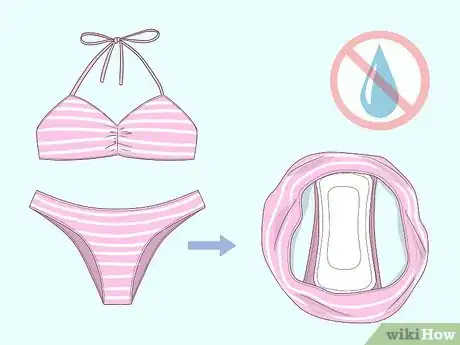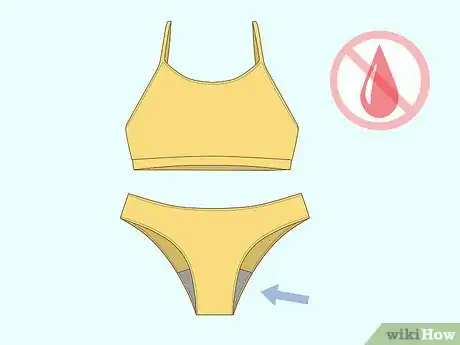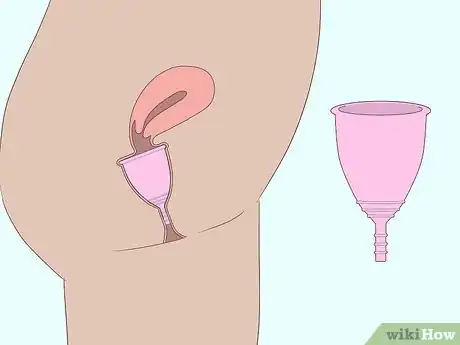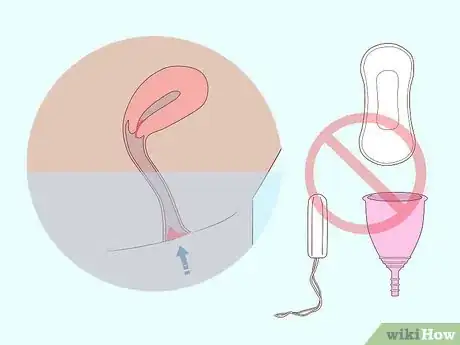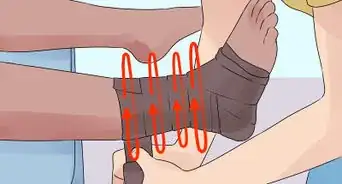This article was co-authored by wikiHow Staff. Our trained team of editors and researchers validate articles for accuracy and comprehensiveness. wikiHow's Content Management Team carefully monitors the work from our editorial staff to ensure that each article is backed by trusted research and meets our high quality standards.
There are 7 references cited in this article, which can be found at the bottom of the page.
wikiHow marks an article as reader-approved once it receives enough positive feedback. This article received 20 testimonials and 80% of readers who voted found it helpful, earning it our reader-approved status.
This article has been viewed 787,981 times.
Learn more...
Want to go to that pool party everyone's going to this summer, but fear you can't because you'll be on your period? Don't worry—you can still swim on your period! If at all possible, you'll be most comfortable swimming with a tampon or menstrual cup instead of a pad, as they will be better at hiding your period. However, if you only have a pad at your disposal, you can swim with one. It's especially double if you're just planning on hanging by the pool or wading in the water without actually getting your suit wet.
Steps
Wearing a Pad
-
1Stick the pad on while your bathing suit is dry. Take it out of the wrapper and stick the back of it onto your bathing suit bottom. Choose a thin one so that it doesn't bulge and make sure you're wearing a suit that fits snugly to your body. If your pad gets wet, it won't be as sticky anymore, so wearing a tighter suit can help keep it in place.
-
2Change your pad often when you're swimming. Because pads absorb water, they become less effective when you're swimming. Plus, they will feel wet and soggy. Every time you get out of the pool, change your pad so that you will still be protected. Keep in mind, though, that it may be difficult to stick a new pad on since you'll be putting it on a wet bathing suit.[1]
Note: While your period doesn't stop while you're in the water, the lack of gravity and the pressure from the pool does help keep the blood inside you. When you get out of the pool, you are more prone to leaking. Wrap a towel around you and go to the bathroom as quick as you can.
Advertisement -
3Opt for a dark-colored bathing suit. Dark colors hide leaks better than lighter colors. Therefore, if you do have a little problem with your pad, it will be less likely to show if you choose a dark bathing suit.[2]
- However, pads with wings are more likely to show on the outside of these suits. If you're not planning to put swimming trunks on, choose pads without wings.
-
4Throw a pair of swimming trunks on top of your bathing suit bottoms. This will make it easier to hide the fact you're wearing a pad, as the wings won't show. Plus, it will help keep the pad in place while you move around.[3]
Using Other Options
-
1Put on absorbent, leak-proof swimwear for a similar experience to a pad. This type of swimwear fits close to your body so you don't leak. It also has a lining to absorb your flow so it doesn't go anywhere but in your swimsuit. This is a good option if you don't feel ready for tampons or menstrual cups or simply can't wear them.[4]
- You can mainly find this type of swimwear online.
-
2Wear a tampon for a disposable alternative. Tampons are a great option for the water because they stay in place and only get a little water-logged. Make sure to tuck the string back along your body so it doesn't show under the edge of the swimsuit. Also, remember to change your tampon every 4-8 hours.[5]
- To insert a tampon, unwrap the plastic or wrapper around it, but leave the applicator in place (if yours has one). You may want to squat or prop one leg up if that's more comfortable. Press the tip of the tampon into your vaginal opening, spreading your vaginal lips (labia) as needed. With the string facing away from your body, push the tampon into your vagina as far as it will go comfortably. Make sure the string is hanging out.
- If yours has an applicator, push it until just the grip and plunger is sitting outside your body. Hold onto the grip with 2 fingers, and press the plunger in to push the tampon into your vaginal opening. Remove the applicator, leaving the string hanging out.[6]
- Even if you haven't had sex yet, you can still wear a tampon. Just pick a slim version if you haven't used one before. Contrary to popular belief, this won't "pop" your hymen. Your hymen stretches around part of your vaginal opening; it doesn't actually cover it. Or, you can wear a condom even a girl.
-
3Try a menstrual cup for a reusable, leak-proof option. A menstrual cup is a small, flexible cup that fits inside your vagina. Rather than absorb blood like a tampon or pad, it collects it. It's held in place by forming a seal with your vaginal wall, so it usually won't leak once you get the hang of it. That makes it perfect for swimming. To insert one, fold it in half once and then in half again so it forms a "C" at the top. Then, push it into your vaginal opening. Once it's in, help it pop out by turning it in place.[7]
- You can find menstrual cups online, in drug stores, or in big box stores.
- Just like a tampon, you can use these cups even if you haven't had sex. However, you should choose one that's on the smaller side.
-
4Go without a product if you have a very light flow that stops in the water. If you're like some women, your flow may be so light that you don't need to use a pad, tampon, or cup. In addition, some women's periods slow down in the water because the water pushes against the vaginal opening. Just be sure to have a towel to wrap around you when you get out to hide any leaks.
- The chlorine will take care of minor spotting in the water, protecting other swimmers from any leaks.
- However, you don't want to do this if you have a heavy period, as others may be able to spot leaks in the water.
-
5Avoid swimming on your period if it makes you uncomfortable. No one can make you swim on your period if you're not comfortable doing it. If you're young, most adults will understand if you tell them. You can just say you're not feeling well if you're too embarrassed to say you're on your period.
Warnings
- Avoid using a pad while swimming if your period is very heavy. Pick another option instead or don't swim.⧼thumbs_response⧽
References
- ↑ https://www.refinery29.com/en-us/swimming-on-period
- ↑ https://hellogiggles.com/lifestyle/stay-comfortable-beach-period/
- ↑ https://www.glamour.com/story/4-ways-to-deal-with-your-perio
- ↑ https://helloclue.com/articles/cycle-a-z/can-you-swim-on-your-period
- ↑ https://www.pennmedicine.org/updates/blogs/womens-health/2016/june/swimming-and-your-period-5-myths-debunked
- ↑ https://www.plannedparenthood.org/learn/health-and-wellness/menstruation/how-do-i-use-tampons-pads-and-menstrual-cups
- ↑ https://www.glamour.com/story/4-ways-to-deal-with-your-perio
About This Article
Before you swim on your period with a pad, keep in mind that using a tampon or a menstrual cup will be more effective, since a pad will absorb a lot of pool water. However, if a pad is your only option, go with a thin pad and be sure to stick it to your swimsuit bottoms when they're still dry. Try to wear a dark swimsuit, which can help disguise accidental leaks, and choose a suit that fits snugly to your body to prevent spillage and hold the pad in place. If you're worried about leaks or the pad being visible, you can wear a cute pair of swim trunks over your swimsuit bottoms! For more tips, including how often to change your pad while you're swimming, read on!
